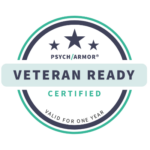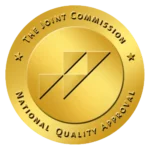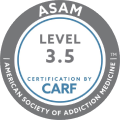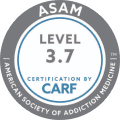
Addiction takes a toll on its victims, but co-workers and employers also pay a high price. Statistics from the National Safety Council show that substance use disorders affect almost 21 million Americans, a group that makes up around 8 percent of all adolescents and adults in the country. Add family members, and that number goes up to about one-third of the U.S. population.
What Addiction Is and How to Spot It
The National Business Group on Health’s Center for Prevention and Health Services provides a guide to substance use in the workplace. It describes what addiction is and how it progresses.
The guide defines addiction as a condition that affects the reward system in the brain, causing behaviors like cravings and an impulsive need for a substance. People who have substance use disorders may want to stop using the chemicals they depend on but are unable to do so. Neurological changes in the brain make it very hard or impossible to say no to the next fix.
When someone uses an addictive substance, the brain releases a “feel-good” chemical called dopamine. Dopamine is a neurotransmitter that causes feelings of euphoria, making users want to experience the feeling again. With every dose, dependency builds, and the need for larger or more frequent doses grows. Users lose the ability to experience the ups and downs of daily life and often become depressed or down when they are not using.
Using a substance is not necessarily a problem in itself; however, when it takes over the user’s life and becomes more important than anything else, addiction has begun. This could occur after the first time or after years of use.
Tolerance and Withdrawal
Someone who uses a drug can be psychologically or physically dependent on the substance. People who are psychologically dependent need a dose to get through the day at work, at home, or in social settings. They make up about 15 percent of chemical-dependent users. Physical dependence usually occurs gradually and includes one or both of the following:
- During the tolerance stage, users need higher doses to get high.
- During withdrawal, users experience symptoms like chills and nausea if they stop using the substance.
Stages of Addiction
- From its earliest stage of development, addiction is a chronic condition that requires lifetime management. This usually means that users need to permanently give up the substance to avoid problems throughout their lives.
- In the second, or progressive, stage, the addiction gradually gets worse.
- In the third stage, addiction becomes an illness in itself, not a secondary symptom of emotional problems. It must be treated for what it is.
- In the fourth stage, continued use leads to organ damage and possible death.
The Cost of Addiction in the Workplace
Three in four people who have substance use disorders also have jobs, and many are high-functioning employees. At the same time, many of their employers are unaware of the problem and the effect it has on morale, health, and their bottom line. The National Safety Council estimates the annual cost at around $442 billion dollars. Much is due to higher health care expenses, lost productivity, and absent employees.
The National Safety Council says drug and alcohol abuse affects businesses in other ways as well
- About 16 percent of users hurt at work test positive for alcohol in the ER.
- Drinking at work can lead to charges of physical and sexual assault.
- Drinking often leads to unnecessary risk-taking.
- Substance withdrawal affects job performance and safety.
- The chance of illicit drug sales at work increases.
- Insurance for workers who misuse pain pills costs three times that of other workers.
The Effects of Drug Use on Family and Co-Workers
Co-workers and family members also pay a high price. Statistics show that
- Approximately one in four workers have substance use in their families.
- Over 40 percent of these workers report they are less productive at work.
- Friends, family, and co-workers of addicted individuals report feelings of stress while at work.
Signs of Drug Use and Addiction at Work
Telltale signs of drug abuse in the workplace show up among workers in the following ways:
- They may have an unkempt appearance or display poor hygiene.
- They may have mood or attitude changes that result in conflict with co-workers.
- They may withdraw from work relationships or new projects.
- They may be defensive if asked about the substance that causes the problem.
- They may be secretive or frequently want to borrow money.
- They may have physical symptoms like bloodshot eyes or alcohol on the breath.
- They may disappear to the bathroom to drink or use drugs.
- They may make mistakes, be less productive, or take unnecessary risks.
- They may talk about vague illnesses or problems at home.
Most Commonly Used Substances in the Workplace
Researchers say that the types of drugs seen most often among workers are alcohol, marijuana, cocaine, and prescription medications. Here are some facts about these drugs:
- Employees who drink alcohol before or during work often find it difficult to get to work on time or do their jobs after they arrive. They may drink secretly at lunch or at business functions, making accidents more likely. This is especially dangerous for those who operate machinery.
- It is easier to get marijuana than ever before. New strains are stronger, and they are sometimes laced with a variety of other dangerous substances. In 2014, CNBC reported that nearly 10 percent of American employees went to work high.
- Although the use of cocaine briefly decreased, its use in the workplace is now going up, especially among professionals trying to meet the demands of a competitive economy and upwardly mobile lifestyle. While cocaine sounds beneficial in the short term, it quickly leads to serious health risks.
- Prescription drug abuse goes far beyond the current opioid crisis. In 2015, over 15 million Americans were abusing prescription drugs. These include the highly addictive OxyContin as well as addictive medications normally prescribed for conditions like insomnia, depression, and anxiety. Workers also turn to prescription stimulants like Adderall to help them focus on details and get more work done.
More Information on Commonly Used Drugs
The National Business Group on Health lists these dangerous drugs and gives examples of their short- and long-term or potentially dangerous side effects:
- Alcohol is a depressant that results in slurred speech, poor memory, and blurred vision. Long-term use can lead to mood disorders, liver diseases, and brain damage.
- Central nervous system depressants, or tranquilizers, cause extreme sleepiness, lack of coordination, and possible seizures. They include prescription medications like Xanax and Valium.
- Heroin is a narcotic that induces feelings of euphoria. It may cause flushed skin and dry mouth. Over time, it can lead to breathing problems and sudden death.
- LSD is a hallucinogen that causes a rapid heartbeat and a loss of touch with reality. Serious complications include hallucinations, psychosis, and depression.
- MDMA, or ecstasy, is a hallucinogen that causes nausea, blurred vision, muscle tension, and teeth grinding. It can result in long-term damage to thinking skills, mood disorders, and poor judgment.
- Marijuana, or cannabis, can cause feelings of euphoria and relaxation, but it can also lead to extreme hunger, thirst, and panic. Long-term use leads to memory damage and respiratory problems.
- Methamphetamine is a stimulant that causes the body temperature to rise, and it sometimes leads to convulsions. More dangerous side effects include psychosis, paranoia, and thoughts of suicide.
- Prescription stimulants cause insomnia, rapid heart rate, and high blood pressure. They may also cause heart problems and seizures.
- Opioids, also known as narcotics or painkillers, cause drowsiness and constipation. More severe effects include breathing problems and death.
- Prescription stimulants like Adderall cause a rapid heartbeat and insomnia when misused. Complications include heart problems and seizures.
Disorders That Exist With Substance Use
The National Institute on Drug Abuse provides the following information for recognizing and dealing with co-existing conditions or comorbidity. Comorbidity is the medical term for two or more illnesses that occur concurrently. The conditions can manifest at the same time, or one may follow the other. Each, however, is affected by the other.
Addiction itself is a mental illness, but it also occurs with other mental illnesses. Addicts often have a pre-existing mental illness that makes them vulnerable to drug use disorders. One in two people who have a mental disorder is likely to develop an addiction sooner or later. The same holds true for addicts who may also develop mental illnesses as a result of their drug use. Scientific research is limited, but researchers think young people with substance use disorders have elevated risks of other mental conditions, such as anxiety, depression, and ADHD.
Causes of Co-Occurring Conditions
When co-existing illnesses occur, figuring out which came first is like the chicken and the egg, but substance abuse and mental illnesses have common contributing factors. Researchers say three theories might explain their connection:
- Some people inherit genes that predispose them to mental illnesses. On the other hand, environmental conditions can alter genes and make a person more susceptible to mental illnesses.
- Mental illnesses increase the risk of substance use disorders.
- Addiction or drug use disorder can increase the likelihood of other mental illnesses.
Treating Co-Existing Mental Illnesses
Medical professionals say that anyone treated for substance abuse should also be evaluated for mental illness and vice versa. The National Institute on Drug Abuse offers these guidelines for treatment:
- Cognitive therapy, also known as CBT, attempts to change thinking patterns, eliminating negative beliefs and habits.
- Dialectical behavioral therapy, or DBT, helps reduce behaviors that contribute to self-harm. These include suicidal thoughts or actions, cutting, and use of drugs.
- Assertive community treatment, or ACT, involves a unique treatment plan and encourages users to get involved in the community.
- Therapeutic communities, or TC, use long-term residential treatment to improve social skills and teach coping strategies.
- Contingency management, or CM, uses a reward system with vouchers to encourage healthy lifestyle choices.
The use of medication for comorbid conditions has not been fully researched. In some instances, such as the simultaneous treatment of depression and smoking, an antidepressant called bupropion helps both.
Whether a substance abuse issue occurs alone or with another illness, it can have devastating effects on the personal and professional lives of those it affects. The good news is that the substance abuse problem can be successfully treated when dealt with as a chronic condition. The journey begins in rehab. If you think a loved one or a co-worker has an issue with substance abuse, a trained specialist can give you more information on rehab facilities in your area.






